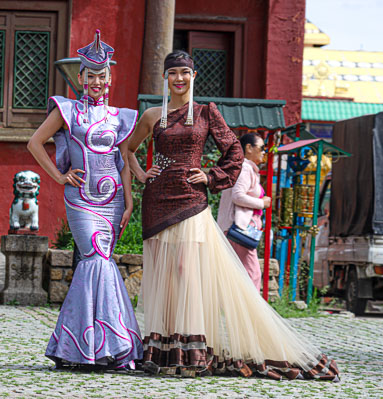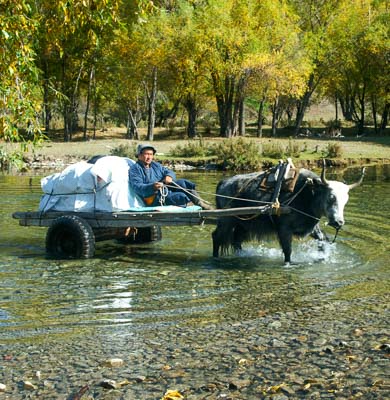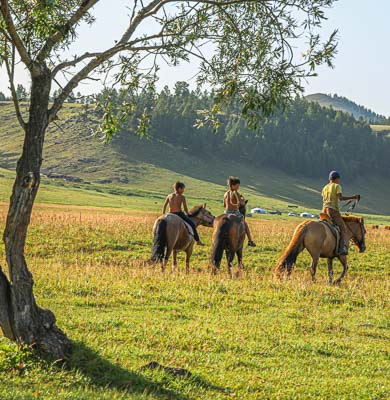Ulaanbaatar is the modern concrete capital city of nomadic Mongolia, outskirts by ger districts, teeming with people, humming with cars and buses.
Ulaanbaatar history
The capital city Ulaanbaatar is situated in the broad valley of the Tuul River among four pine, fir, and larch-covered mountains; Bogd Khan Mountain in the south, Bayanzurkh Mountain in the east, Chingeltei Mountain in the north, and Songino Khairkhan Mountain in the west.
Initially, the city was founded 300 km southwest of the current Ulaanbaatar location in 1939. As a nomadic country, the first capital was named "Urguu," a word for big traditional dwelling ger. Indeed, they built this big ger for Mongolian first religious leader Zanabazar. Since then, the nomadic ger settlement moved 28 times between 1640 and 1855, including some short distance movements after settling the current day location in 1778. The city expanded with thousands of gers and temples between 1640 and 1778 and was named Ikh Khuree or Great Temple Settlement between 1640 and 1910. By the end of the 19th century, Ikh Khuree was the center of politics, economics, trade, and religion, inhabited by 15,000 to 20,000 people. There were no brick and stone temple constructions until 1837.
The city was renamed Niislel Khuree, meaning A Capital Settlement consists of Temples, when it became the political capital of autonomous Mongolia in 1911. After the Mongolian People's Revolution of 1921, the city name changed to Ulaanbaatar in 1924, meaning Red Hero. Most of the temples and monasteries were destroyed and closed during the Communist purge of the 1930s. Even though, today, you can see several functioning old monasteries and monastery museums in Ulaanbaatar. During the 20th century, many of the felt ger encampments gave way to Soviet-style apartment blocks and government buildings.
There was a transition in the 21st century - mining investments increased, tourism started developing, and the country gained popularity of resources.
Nowadays, skyscrapers, shiny office buildings, high-end hotels, shopping malls, and abundant choices of fine restaurants co-exist the nomadic dwelling ger districts.
Ulaanbaatar, a travel hub of Mongolia
Ulaanbaatar is a travel hub of Mongolia as the city host only an international airport and the central station of the famous Trans-Mongolian railroad, connected with Trans-Siberian and Trans-China railroads. The majority of the countryside tours starts from Ulaanbaatar.
Unlike the other countries, infrastructure developed less, and tourism is in its infancy, allowing the visitors to Mongolia to enjoy vast-open landscapes, pristine nature, and the people's hospitality.
Many budget travelers arrive in Ulaanbaatar to find out that their budget is not abundant to do anything in Mongolia unless they spend most of their time in Ulaanbaatar.
As a travel hub, bigger towns connected with Ulaanbaatar by paved roads. Although, the remoteness of the attractions and scenic places force the budget travelers to hire a car for hundreds of kilometers driving after getting off the buses at town bus stations. Therefore, the best is to join a group tour and book tours online in advance. We have a vast selection of confirmed group tours and private tours.
Ulaanbaatar population
2022 Ulaanbaatar's official population is 1,597,290. However, unofficially well over that number, reflecting the drift of incoming movement of nomadic herders, students, and local unemployees seek jobs. You will find out the Ulaanbaatar population is relatively young. The older people desire to live in the countryside, in the traditional gers and houses in the suburb.
Is Ulaanbaatar dangerous?
Ulaanbaatar is one of the safest cities. First of all, be careful of pickpockets in the streets, public transport, shops, markets, and while visiting monasteries.
Second, avoid walking in the dark. Some of the drunk guys tend to be harmful.
Top attractions in Ulaanbaatar
Both short-term and long-term travelers visiting Mongolia do not miss top things to do in Ulaanbaatar and Attractions near Ulaanbaatar, which we recommend based on our experience and clients' feedback, or attend Ulaanbaatar sightseeing tour.
Mongolian restaurants in Ulaanbaatar
There are countless high-class European, American, Asian, middle-east, and Mongolian restaurants. Either, the Hallal meals and vegetarian meals are available in the city. Among them, we suggest you visit the following restaurants for Mongolian meals;
1. Modern Nomads Restaurant.
2. Mongolians Restaurant
3. Bd's Mongolian Barbecue
4. Khukh-Uur, serve the famous Mongolian beverage Airag/kumis
5. Zochin 999 Restaurant
Ulaanbaatar public transport
Public transport is extensive and cheap in Ulaanbaatar. A one-time adult ride costs 300 MNT for trolleybus and 500 MNT for the bus in the city, not regarding the distance. However, you should buy a prepaid card in advance from the counters at the bus station (not all counters sell bus cards) and press it when getting in the front door of a bus. Passengers get off at the middle and back doors. The bus card costs 5000 MNT, plus pay ride fare depending on how often you would like to use the public transport. Fellow travelers could buy one card and press it two times. Watch out for the pickpockets when traveling by public transport.
Taxis in Ulaanbaatar
The official taxi ranks are usually at airports, railway stations, and larger hotels. We advise you to ask your hotel receptionist or concierge to call a taxi for you for reliable service and a fair fee. You will not see many official taxis in Ulaanbaatar. Although, any car could stop when you stretch your hand moving up and down. Those are private cars that serve as taxis. Do not catch private car taxis if you can not speak the Mongolian language. You better negotiate the fare before you hop into a taxi because some drivers can charge exorbitant fares. Or do you need a car for long-distance, we will be happy to help you.
Interesting facts about Ulaanbaatar
1. Coldest capital - Ulaanbaatar is the coldest capital city with an average temperature of -29°C. The temperature drops down to -45°C some years.
2. Mongolians gathered in Ulaanbaatar - 48% or almost half of the Mongolian population resides in Ulaanbaatar, making the rest of the country empty.
3. World's oldest officially protected area - Bogd Khan Mountain is the oldest legally protected natural area of the world, preserved since 1778.
4. The city moved 28 times - Indeed, the Mongolian capital was a mobile settlement, consisting of nomadic dwelling gers and ger temples. The location of Ulaanbaatar changed 28 times due to the season, needs, pasture, and water. Nowadays, still, the governors are considering moving the capital. Nomadic culture and demand to sparse the city population!
5. One of the world's largest land capital cities - Ulaanbaatar's territory covers 4704.4 km2 of the area, consisting of 9 districts. Two of the district's locations are 120 km from the downtown, respectively. Baganuur district is located 120 km east of Ulaanbaatar and Bagakhangai district another 120 km to the southeast of Ulaanbaatar.
6. Talented drivers - You will find many talented drivers on Ulaanbaatar's busy roads.
7. The city has a young population - 51% of Ulaanbaatar's population is below 30 years
8. Huge ger district in Ulaanbaatar - 60% of Ulaanbaatar's households live in the ger district, an area named after the traditional felt dwelling ger.
9. The city was built on the coal resource - Ulaanbaatar's coal mining districts Nalaikh and Baganuur territory covers coal resources.
10. Buy best quality cashmere - Do not miss visiting the cashmere factory store. Check and buy well-fashioned, best quality Mongolian cashmere clothes. Mongolia is famous for its cashmere.
11. Dinosaur museums - Ulaanbaatar's small dinosaur museums display rare dinosaur fossils and complete skeletons.
12. No many official taxis in Ulaanbaatar - It is hard to find official taxis in Ulaanbaatar, but any private car can stop serving as a taxi.
13. Safe city - Ulaanbaatar is one of the safest cities in the range of violent crime and other physical hazards.
14. Red meat market - You may know that Mongolia is known for its 67 million heads of livestock (as of 2022) grazing fenceless feeding on the natural grasses. Therefore, meat is the main ingredient of Mongolian meals. It might not be a good idea. However, visiting the raw red meat market Denjiin Myanga could be some of the spectacular things you may not see in many countries. On the meat market, you will find all kinds of grass-fed organic meats such as beef, mutton, goat meat, horse meat, camel meat, yak meat, and of course, the intestines, heads, legs and jerked meat, etc.


